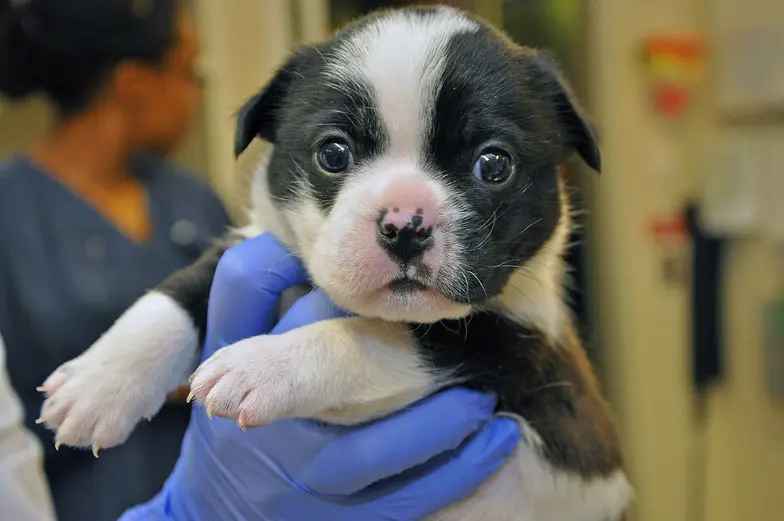Canine Parvovirus

Canine parvovirus (CPV) is a highly contagious unenveloped virus that affects dogs and is a significant disease concern in shelters. Common clinical signs include lethargy, vomiting, and diarrhea. Puppies and unvaccinated adult dogs are most susceptible. Mangement in shelters requires strict isolation of affected dogs and aggressive supportive care.
The virus can persist in the environment for extended periods of time. Fortunately, certain disinfectants (e.g., accelerated hydrogen peroxide, dilute bleach) are effective against this pathogen.
What You Should Know
Canine parvovirus infects and kills rapidly dividing cells, such as those in the bone marrow and intestines. Infected dogs often develop diarrhea because of damage to cells lining the intestines.
The most common clinical signs of CPV are acute vomiting and diarrhea, often severe. The diarrhea may or may not be bloody. Affected dogs are typically lethargic and can quickly become dehydrated. Puppies under five months and dogs who have never been vaccinated are at greatest risk for infection.
CPV is very hardy in the environment and is easily spread via direct contact between dogs or fomite transmission. Clinical signs typically develop 2-14 days following exposure. Not all exposed dogs will become infected or develop signs of illness. When illness does occur it happens most commonly 4-7 days after exposure, but time to development of clinical signs can range from as little as 2 days to as long as 2 weeks. Viral shedding can begin a few days prior to development of clinical signs and can continue for up to ~2 weeks following recovery.
A diagnosis of CPV is made by evaluating the animal’s history and clinical signs in conjunction with diagnostic tests. Not all cases of bloody diarrhea and vomiting are caused by CPV, so a definitive diagnosis should be sought to help guide treatment and management decisions in the shelter.
There are several tests that can be used to diagnose CPV, including the in-house ELISA test kits (e.g. SNAP® test) and PCR (polymerase chain reaction) tests sent to commercial laboratories. A complete blood count (CBC) or blood smear also provide valuable information to aid in diagnosis. Each test provides slightly different information, and sometimes more than one type of test may be combined for optimal diagnosis.
The fecal CPV ELISA antigen tests are the test of choice in the shelter environment. These tests, which utilize a fecal swab to detect CPV antigen, provide quick results (usually within 10-15 minutes) and can easily be performed by staff in the shelter. Positive results are a reliable indicator of infection when associated with consistent clinical signs. Negative results may occur even when the dog is infected if the level of virus in the sample is low – this can be seen early in the course of disease or when clinical signs are mild.
The ELISA test should be completed on any dog displaying clinical signs consistent with CPV infection but should not be used in healthy-appearing animals. Recent vaccination (within 7 days) with a modified-live virus parvovirus vaccine can occasionally result in false positive ELISA test results.
The PCR test can also be a reliable indicator of CPV infection when clinical signs are present. However, there is a delay in definitive diagnosis since the test cannot be performed in shelter. This test can also be affected by recent vaccination, making results difficult to interpret.
A CBC can be done in-house in many shelters or sent to an outside laboratory. This test can determine if the white cell count is low, a common finding in many CPV cases. A CBC is not a definitive diagnosis of CPV, but it can support a positive diagnosis if the initial diagnostic test was equivocal and can help assess the overall clinical picture of infected dogs. If performing a CBC is not possible, a blood smear may instead be performed in-house to look for evidence of a low white blood cell count.
Necropsy along with histopathology can provide a definitive diagnosis of CPV infection. This should be performed any time there is unexplained death in shelter dogs.
Individual Dog
When appropriate treatment can be provided, the prognosis is generally good for CPV-infected dogs. There is no specific anti-viral treatment, so treatment consists of providing supportive care, including antibiotics to combat secondary bacterial infections, fluid therapy to correct the dehydration, pain control, broad-spectrum deworming, nutritional support, and control of vomiting and diarrhea. A recently approved monoclonal antibody treatment may shorten the duration of illness and improve outcomes, and shows promise for use in a shelter setting.
While some animals may require hospitalization and intensive care, many can be successfully treated with less intensiveprotocols. Several of these protocols have been published in veterinary journals and summarized in review articles. The various protocols provide a spectrum of care approach which allows shelters to better manage limited resources with successful outcomes at a similar rate seen with more expensive, intensive approaches
Traditional treatment approaches for CPV Infection typically occur in an intensive care setting. While this intensive care may be necessary for severe or complicated cases, outpatient and less intensive protocols are invaluable in situations where available resources are limited, which is frequently the case in shelters and access to care settings. Outpatient and daytime hospitalization protocols can be a solution when expensive, labor-intensive care isn’t feasible or necessary.
Both approaches have provisions for the same type of initial stabilization and ongoing supportive care, but differ in the delivery of this care. The outpatient protocols, summarized in the review article above, rely on owners or foster caregivers to provide that ongoing care outside of the shelter or clinic. The daytime hospitalization protocol outlines an approach where care is provided in the clinic setting, but during daytime hours when staff are more readily available. This protocol may be particularly helpful when logistical issues impact an owner or foster caregiver’s ability to bring the dog to the shelter or clinic every day for outpatient care, and when 24 hour care isn’t feasible or necessary. Check out the ASPCA Animal Hospital Daytime Parvo Hospitalization Protocol to see if it’s appropriate for your shelter to consider as part of its spectrum of care treatment options for parvo patients.
Regardless of the treatment protocol, once clinical signs resolve, an ELISA test can be utilized to determine if virus is still being shed. Once viral shedding has ended the dog should be bathed before being placed back into the shelter population.
The decision to treat in the shelter should be made while considering available resources and the ability to prevent transmission to the rest of the shelter population. Use the resource assessment tool to aid in making decisions about treatment plans.
Outbreak Response
Be prepared ahead of time with a detailed CPV response protocol for your shelter developed by, or in consultation with, your shelter’s veterinarian. Promptly isolate diagnosed cases from the remainder of the population. Effectively sanitize or discard any exposed areas or items. Ensure appropriate notification and equipment are in place to institute biosecurity measures.
Categorize dogs as:
- Infected = diagnosed CPV cases
- Exposed = dogs with the potential of disease exposure from infected dog(s). This will include any dogs co-housed with affected canines and may include dogs housed in the same kennel unit depending on biosecurity practices. If the infected dogs have moved throughout the shelter or if biosecurity practices are lacking, the entire canine shelter population may be exposed.
- Unexposed = dogs with no significant potential of disease exposure
Use this flowchart as a guide to develop a response plan for your shelter population in the event of a CPV outbreak.
Vaccinating & Deworming
Vaccinate animals at intake. The modified-live CPV vaccine is excellent and provides rapid protection against viral challenge. Vaccinate puppies in the shelter starting at 4 weeks of age using a modified-live CPV vaccine, with boosters every 2 weeks, until 20 weeks of age. Evidence indicates one modified-live vaccine likely provides lifelong immunity in adult dogs; however, in high-risk situations it is advisable to repeat the vaccination in 2 weeks. Deworm routinely with a board spectrum anthelminthic.
Sanitation
It is important to clean and disinfect any surfaces animals may come into contact with, not just the kennels. Promptly remove fecal waste and thoroughly clean the area. Use the disinfectant chart to find the most appropriate choice for your shelter. Follow good Personal Protective Equipment practices. Utilize shoe covers or dedicated boots in isolation areas. Do not use foot baths, which can spread disease rather than prevent it.
Maintain a dedicated set of cleaning equipment for individual rooms or wards. Avoid using mops to clean. If clothing, bedding, or towels are heavily soiled consider discarding the items. If items are laundered use hot water and a good quality detergent and ensure large debris, such as fecal material, is removed prior to laundering. Do not overload the washing machine and use a clothes dryer rather than hanging items to dry.
Reducing Crowding and Stress
Crowding is a substantial risk factor for most infectious diseases in the shelter because it leads to greater risk of disease being introduced, higher contact rates between animals and people, increased stressed, and compromised animal care. Reduce length of stay, utilize low stress handling techniques, and provide humane housing (with separation of sick animals from healthy animals) to reduce the risk of disease transmission. Establish routines for cleaning, feeding, and playing. Provide bedding and toys (disposable or disinfectable) for enrichment. Turn lights off at night so animals can sleep. Reduce noise levels and play soft music.
If treatment in the shelter is not an option, shelters can consider in-patient treatment at a private veterinary clinic or out-patient treatment in a foster home setting.
If the shelter elects out-patient treatment, veterinary involvement is crucial for protocol development and guiding individual treatment decisions. In addition, caregivers must receive appropriate training in biosecurity protocols, including the use of personal protective equipment and proper sanitation protocols.
Downloads
- Shelter Disinfectant Quick Reference
- Infectious Disease Resource Assessment Tool
- CPV Outbreak Flowchart
- Daytime Parvo Hospitalization Protocol
Additional Resources
- Evaluation of an outpatient protocol in the treatment of canine parvoviral enteritis
- Retrospective evaluation of outpatient canine parvovirus treatment in a shelter-based low-cost urban clinic
- Parvo Basics webinar
Last reviewed August 2024


